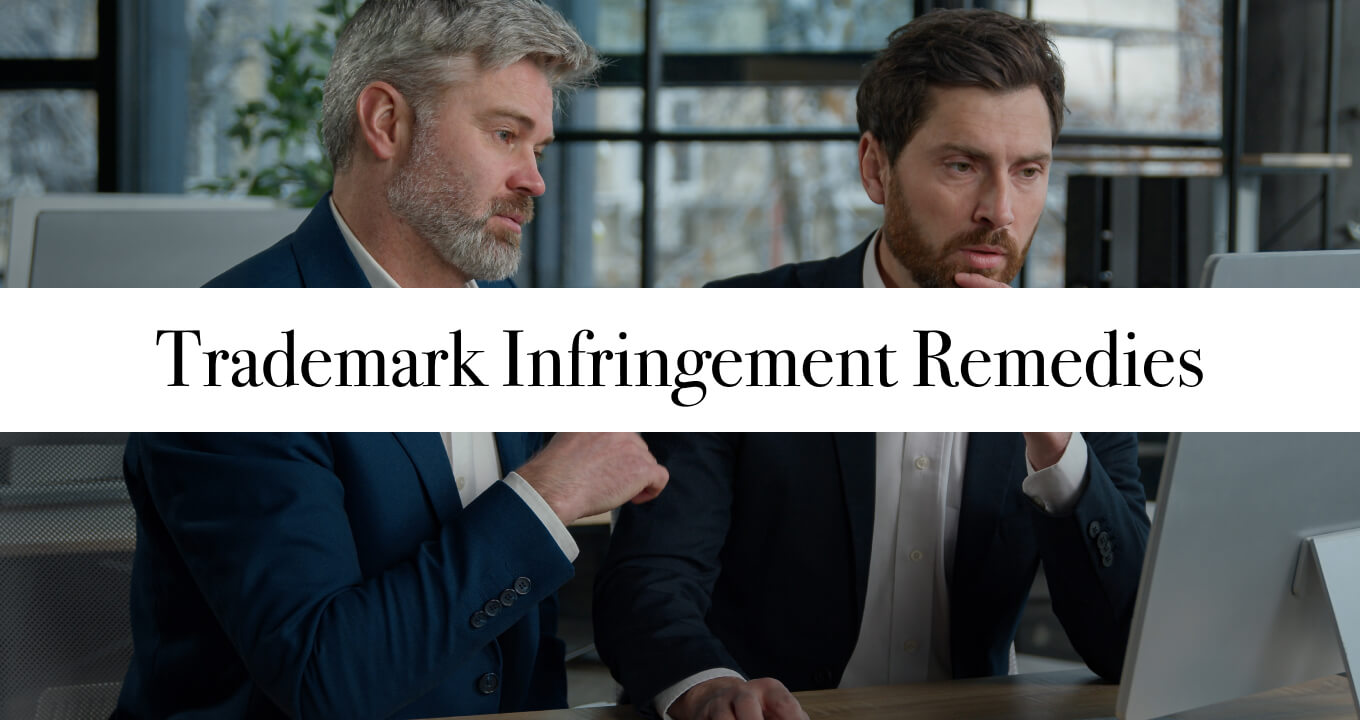Originally posted on May 14, 2024 @ 7:47 pm
Exploring the world of Trademark infringement sure feels like wandering through a maze for businesses! Imagine your favorite sneakers but someone else flaunts them as their own – that’s the unsettling experience at hand. Such events not only leave buyers scratching their heads but also **damage** the brand’s good name. If someone steps over the line and uses a trademark without a nod from the owner, knowing the legal steps to take becomes crucial. Learn how to tackle these sticky situations and keep the brand’s light shining fiercely. Tags: entrepreneurs, startups, business leaders.
Remedies serve not only as a means of compensation for the aggrieved party but also as a deterrent against future infringements. The legal framework offers various trademark infringement remedies, including injunctive relief, monetary damages, and in some cases, the recovery of profits made from unauthorized use.
Navigating the complexities of trademark law requires an awareness of the types of remedies that can be pursued. The appropriate remedy in a case of trademark infringement will often depend on the specifics of the infringement and the harm caused to the trademark owner.
While injunctions can prevent further infringement, monetary damages and profits aim to compensate for financial losses. Consequently, understanding how to calculate damages and profits is essential for establishing a fair remedy.
Additionally, defendants may have several defenses available to them, which could impact the outcome of a case. The role of courts is fundamental in these legal proceedings, as they interpret the laws, assess the evidence, and make decisions on the appropriate remedies.
Key Takeaways
- Trademark infringement can lead to serious legal consequences and remedies are designed to mitigate the damage.
- Various types of remedies are available, including injunctive relief and financial compensation, which are determined based on the case specifics.
- Effective trademark protection strategies are essential to prevent infringement and uphold the integrity of a brand.
Understanding Trademark Infringement
When addressing the topic of trademark infringement, it’s crucial to dissect its components, understand the various types of trademarks, and consider the role intent plays. Each of these facets contributes to a comprehensive grasp of how trademark law operates to protect brands and consumers from confusion.
Elements of Infringement
Trademark infringement occurs when an unauthorized use of a trademark or a substantially similar mark is likely to cause confusion among consumers regarding the source of goods or services.
The critical factors include:
- Use: The mark must be used in commerce in connection with goods or services.
- Similarity: The defendant’s mark must be similar to the plaintiff’s registered trademark, leading to likelihood of confusion.
This confusion might arise over the source, sponsorship, or affiliation of the goods or services.
Types of Trademarks
Trademarks encompass a variety of categories, each serving as a unique identifier for goods or services. They can include:
- Word Marks: Distinct words or phrases.
- Logos: Graphic symbols or icons.
- Shape Marks: Unique product shapes or packaging.
- Color Marks: Use of specific colors in association with a brand.
Each type is subject to trademark law scrutiny when assessing infringement.
Role of Intent in Infringement
While intent is not a prerequisite for infringement, it can be a pivotal factor in determining the outcome of a legal dispute.
We distinguish two types of intent:
- Innocent Infringement: The infringer unknowingly uses a similar mark.
- Willful Infringement: The infringer knowingly and deliberately copies the mark.
In cases where willful infringement is proven, more severe remedies may be imposed.
Regardless of the intent, if a likelihood of confusion amongst consumers about the source or affiliation of the goods or services exists, trademark protection may come into play.
Legal Framework
In addressing remedies for trademark infringement, we focus on the established legislation and judicial precedents that provide a structure for litigation and compensation.
Lanham Act
The Lanham Act serves as the primary statute governing trademark law in the United States. Its scope extends to providing remedies for trademark infringement, particularly when a registered mark is used without the owner’s consent. Crucially, it outlines that trademark owners may seek damages, including profits lost due to infringement, costs of the action, and in certain cases, treble damages for willful infringement.
Federal Circuit Precedents
Precedents set by the Federal Circuit further interpret the Lanham Act and influence how courts apply the law. Over time, these precedents have provided clarity on aspects such as proving likelihood of confusion and the quantification of damages. They ensure uniform application of legal principles across federal courts and guide trademark owners in protecting their intellectual property.
International Trademark Laws
While the USPTO governs the registration of trademarks within the United States, international trademark laws come into play for infringement across borders. Agreements such as the Madrid Protocol provide a framework for the international registration and protection of trademarks.
Trademark owners must navigate a complex web of national and international laws to enforce their rights in global markets, where remedies may vary significantly.
Trademark Infringement Remedies
When addressing trademark infringement, it’s crucial to understand the range of legal remedies that can be pursued. These include specific actions to prevent further misuse, financial compensation for losses suffered, and orders to remove infringing products from the market.
| Types of Remedies | Legal Proceeding |
|---|---|
| Injunctive Relief | Injunctive relief is a court-ordered act that either restrains a party from continuing infringing activities or mandates specific actions to prevent ongoing infringement. This can include immediate cessation of the use of a trademark, helping ensure that a successful plaintiff stops the defendant from causing further harm to the brand’s reputation. |
| Monetary Damages | Monetary damages are awarded to compensate the trademark owner for the losses incurred due to infringement. These can include actual damages, calculated as the lost profits due to the infringement, or the defendant’s profits from the wrongful use of the trademark. The court may also award a sum that is indicative of a reasonable royalty. In certain cases, where the infringement is found to be intentional, treble damages may be awarded to deter future infractions. |
| Destruction and Forfeiture | Courts can also order the destruction of infringing merchandise and materials, effectively removing from commerce any goods that bear the unauthorized mark. Forfeiture can further extend to confiscating profits made from the sale of such goods. Additionally, the successful plaintiff may sometimes recover attorneys’ fees, especially in cases where the infringement was willful or egregious. |
Calculating Damages and Profits
When addressing trademark infringement, we focus on the proper compensation to the aggrieved party and the profits reaped by the infringer due to the violation.
Factors Influencing Damages
In calculating damages for trademark infringement, several elements are considered. These include the likelihood of confusion and the strength of the trademark.
The degree of care the average consumer exercises when purchasing the trademarked goods can also affect the damages awarded.
Lastly, if there’s evidence of trademark dilution, it can further impact the damage calculation.
Defendant’s Profits Calculation
To calculate the defendant’s profits, we examine their sales records and the profits gained from using the infringed trademark. It’s essential to differentiate between the profits directly attributable to the violation and those not related.
We must investigate the marketing channels used by the defendant to determine the extent to which the infringement led to illegitimate gains.
Punitive Damages
Punitive damages may be considered when the defendant’s actions are especially malicious or egregious. These damages serve both to punish the defendant and to deter future acts of infringement.
Punitive damages are not awarded in every case and are dependent on the specific circumstances of the violation.
Defenses to Trademark Infringement
When facing allegations of trademark infringement, we have specific defenses that can be raised to counter the claims. These defenses are rooted in established legal doctrines and are critical to ensure that our rights are not unduly restricted.
Fair Use Defense
Nominal Fair Use — We may argue that the use of a trademark is permissible when it’s used descriptively to refer to an aspect of our product, or to compare our goods to another entity’s.
Classic Fair Use — This doctrine allows us to use a protected trademark to describe our own products, not the competitor’s goods. We are entitled to use descriptive terms that are part of the public domain, as long as we do so in good faith.
Parody as a Defense
A parody of a trademark does not always constitute infringement. When we create a parody, our use must conjure up the original, but also distinguish itself and convey that it is not the original trademark. It must also provide social commentary or comedic effect related to the trademark or its owner.
First Amendment Considerations
The First Amendment intersects with trademark law, where it can offer us a defense against infringement claims. Expressive use of a trademark that is part of artistic, literary, or political expression, and is not merely a commercial ploy, may offer us protection under the First Amendment.
Our use must balance the public interest in free expression against the public interest in avoiding consumer confusion.
Successful defenses have included laches, where the trademark owner has unreasonably delayed in asserting a claim, estoppel, for situations when the owner has given us the indication that they won’t assert their trademark, and unclean hands, which applies if the trademark owner has acted unethically or unfairly.
The Role of Courts and Legal Proceedings
Before engaging in trademark litigation, it’s imperative to understand the pivotal role that the legal system plays. The courts adjudicate disputes, uphold trademark laws, and enforce remedies.
Summary Judgment and Trials
In trademark infringement cases, we often find ourselves before a judge who determines whether the case warrants a trial.
Summary judgment is a legal determination made by a court without a full trial when there are no disputed material facts requiring a jury’s deliberation. If granted, it can expediently conclude a part, or all, of a lawsuit.
Trials, on the other hand, are more expansive and involve the presentation of evidence and legal arguments by both the plaintiff and the defendant before either a judge or jury.
Should a trial proceed, we expect a robust debate over the likelihood of confusion and the use of the trademark in commerce, which are central issues in these legal battles.
Appeal Process
Post-trial, the losing party may seek an appeal. This requires presenting the case to a higher court, which is either a state court of appeals or federal circuit court, depending on the jurisdiction of the initial trial.
The appeals court scrutinizes the previous proceedings for legal error and evaluates the application of law. Appellate courts serve as a critical checkpoint, ensuring that the law is interpreted correctly and consistently.
Critically, throughout these proceedings, legal advice becomes a cornerstone—not only for navigating the complex terrain of trademark law but also for craftily drafting cease and desist letters or assessing a brand’s likelihood of expansion.
Protecting Trademarks Effectively
In our role as stewards of brand integrity, it’s crucial for us to implement robust strategies that shield intellectual property, particularly trademarks, from misuse.
We must consider both proactive measures and reactive responses to ensure the continued strength and recognizability of a trademark.
Proactive Measures
Registration: As trademark owners, our first line of defense is registering a trademark with appropriate authorities. This formalizes our claim to the trademark and grants us exclusive rights, which are vital for taking legal action against infringement.
Vigilance: Monitoring the market is essential. We must keep an eye on new trademarks applications, advertising streams, and internet activities that may encroach on our intellectual property.
Tools like watch services can alert us to potential conflicts, allowing us to act swiftly.
Education: Educating our marketing and advertising teams about the nuances of our registered trademarks helps prevent self-inflicted wounds. By understanding the boundaries of our protectable trademark rights, we reduce the risk of inadvertently diluting our brand’s strength.
Reactive Responses to Infringement
Cease and Desist: Upon detecting infringement, a well-crafted cease and desist letter can be our first step in halting unauthorized use. It’s a direct method that often resolves issues before they escalate.
Legal Action: Should the infringement persist, initiating a trademark infringement lawsuit is our recourse.
Swift and decisive legal action reaffirms the seriousness with which we protect our brand reputation and rights.
Settlement: In certain cases, we may opt to settle disputes out of court.
Settlements can offer a faster resolution and may include terms that prevent future confusion among consumers, while safeguarding our marketing efforts.
Best Practices and Key Remedies
In the realm of trademark law, proper measures and adherence to legal standards are paramount for businesses to protect their intellectual property rights effectively. Our exploration of trademark infringement illuminates the complexities and various remedies available to a successful plaintiff.
Best Practices
- Register the Trademark: Ensuring that your mark is registered gives you a legal presumption of ownership and exclusive rights to its use.
- Monitor Your Mark: Being proactive in monitoring your mark can prevent infringement and potentially avoid long legal battles.
- Swift Legal Action: If infringement occurs, taking immediate legal action can avert the dilution of your famous mark.
- Professional Legal Advice: Consulting with experienced attorneys ensures you navigate the trademark territory accurately. They provide crucial counsel on whether a case should be pursued and the potential remedies.
Key Remedies for Infringement
- Injunctions: Courts often grant an injunction to prevent further infringement.
- Damages: Monetary compensation for losses suffered due to infringement.
- Profits: A court may award the infringer’s profits derived from the infringement to the trademark owner.
- Destruction of Infringing Goods: This remedy helps eliminate goods from the market and prevent future loss.
By adhering to these practices and understanding the possible legal outcomes, we can both safeguard our assets and respect the intellectual property of others.
Maintaining vigilance and seeking informed legal advice are critical steps in protecting and enforcing our trademark rights.






